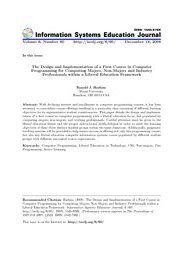Volume 6
Volume 6, Number 60 |
December 18, 2008 |
Abstract: With declining interest and enrollments in computer programming courses, it has been necessary to consolidate course offerings resulting in a particular class consisting of different learning objectives for its representative student constituencies. This paper details the design and implementation of a first course in computer programming with a liberal education focus, but populated by computing majors, non-majors, and working professionals. Careful attention must be given to the liberal education theme and the proper instructional methodologies in order to meet the learning objectives of these three distinct student groups within the same classroom. Additionally, pragmatic teaching maxims will be provided to help ensure success in offering not only this programming course, but also any liberal education computer information systems course populated by different student groups with different associated course expectations.
Keywords: Computer Programming, Liberal Education in Technology, CS0, Non-majors, Pair Programming, Active Learning
Download this issue: ISEDJ.6(60).Harkins.pdf (Adobe PDF, 12 pages, 490 K bytes)
Preview the contents: Harkins.j0.txt (ASCII txt, 39 K bytes)
Recommended Citation: Harkins (2008). The Design and Implementation of a First Course in Computer Programming for Computing Majors, Non-Majors and Industry Professionals within a Liberal Education Framework. Information Systems Education Journal, 6 (60). http://isedj.org/6/60/. ISSN: 1545-679X. (A preliminary version appears in The Proceedings of ISECON 2007: §2524. ISSN: 1542-7382.)
